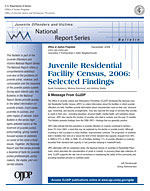
All OJJDP publications may be viewed on and downloaded from the publications section of the OJJDP Web site. Print publications also may be ordered online at the National Criminal Justice Reference Service (NCJRS) Web site.
Now Available
Juvenile Residential Facility Census, 2006: Selected Findings (Bulletin)
NCJ 228128
 OJJDP sponsors the nation's most comprehensive data collection program on juvenile offenders in custody and the facilities that house them. Included among OJJDP's constellation of surveys is the biennial Juvenile Residential Facility Census, which collects information about the facilities in which juvenile offenders are held. Facilities report on characteristics such as their size, structure, type, ownership, and security arrangements. They also describe the range of services they provide to youth in their care, including education, physical health, mental health, and substance abuse services. In addition, facilities report on the number of deaths of youth in custody during the prior 12 months. Data indicate that the population of juvenile offenders in custody decreased 3 percent from 2004, a trend that may be explained by the decline in juvenile arrests.
OJJDP sponsors the nation's most comprehensive data collection program on juvenile offenders in custody and the facilities that house them. Included among OJJDP's constellation of surveys is the biennial Juvenile Residential Facility Census, which collects information about the facilities in which juvenile offenders are held. Facilities report on characteristics such as their size, structure, type, ownership, and security arrangements. They also describe the range of services they provide to youth in their care, including education, physical health, mental health, and substance abuse services. In addition, facilities report on the number of deaths of youth in custody during the prior 12 months. Data indicate that the population of juvenile offenders in custody decreased 3 percent from 2004, a trend that may be explained by the decline in juvenile arrests.
Juvenile Residential Facility Census 2006: Selected Findings may be viewed and downloaded from the publications section of the OJJDP Web site. Printed copies may be ordered on the NCJRS Web site.
Coming Soon
Youth's Needs and Services: Findings From the Survey of Youth in Residential Placement (Bulletin)
NCJ 227728
The Survey of Youth in Residential Placement (SYRP) interviews juveniles, providing an unprecedented inside look at their experiences in custody. To assist practitioners, policymakers, and the public in better understanding SYRP, OJJDP has launched a bulletin series that describes in detail the study and research findings. The second bulletin in the series, Youth's Needs and Services; Findings From the Survey of Youth in Residential Placement, includes comprehensive information about juveniles' recent mental and emotional symptoms, experiences associated with emotional problems, and available treatment for such problems.
Causes and Correlates of Girls' Delinquency (GSG Bulletin)
NCJ 226358
Although the literature examining the causes and correlates of male delinquency is extensive, the extent to which these factors explain and predict delinquency for girls remains unclear. This publication, the fifth in the GSG bulletin series, summarizes the results of an extensive review of more than 1,600 articles and book chapters from the social science scientific literature on individual-level risk factors for delinquency and factors related to family, peers, schools, and communities. The review, which focused on girls ages 11 to 18, also examined whether these factors are gender neutral, gender specific, or gender sensitive. To better understand the causes and correlates of girls' delinquency, this bulletin examines evidence from research studies that have explored the dynamics of girls' delinquency and risk behavior.

